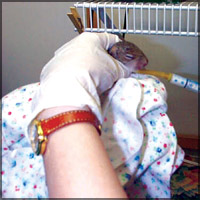Pet Den
Caring for a baby squirrel
 Pets are beings that can bring a lot of pleasure to their owners.
However, right at the beginning of this article, you children should
take in to your minds that having a pet is not about imitating your
friends or trying to show how cool you are. Pets are beings that can bring a lot of pleasure to their owners.
However, right at the beginning of this article, you children should
take in to your minds that having a pet is not about imitating your
friends or trying to show how cool you are.
The right reasons for bringing a pet into your life include
companionship, a desire to care for an animal, and a true admiration for
the beauty of the animal itself as a creature of Nature.
With that in mind, let’s look at a situation that you might probably
face in the near future. Imagine that you are having a stroll with your
friends and suddenly you come across a little squirrel that has perhaps
fallen off its nest. What can you do to take care of it and probably
make it your pet? Let’s find out.
First of all, the baby squirrel should be examined for injuries, and
if it is bleeding or appears injured, the best thing would be to take it
to the veterinary surgeon. If not, you should check whether it is
dehydrated(lacking in moisture).
This can be done by observing the mouth and nose for dryness or
checking for skin pliability(flexibility). Checking for skin pliability
can be done by pulling on the skin a little bit and the skin will ‘tent’
or remain extended for a few seconds if it is dehydrated.
 Moreover, a dehydrated or cold baby will be grayish pink with grayish
gums and lips, and it will ball up, be unresponsive, sluggish or lie
still. It will look thin and feel cold to your touch. Moreover, a dehydrated or cold baby will be grayish pink with grayish
gums and lips, and it will ball up, be unresponsive, sluggish or lie
still. It will look thin and feel cold to your touch.
Prior to any treatment, the baby squirrel’s body must be warmed to be
between 98 to 102 degrees Fahrenheit. This can be done by wrapping the
animal in a warm towel; keep repeating this step until the body
temperature is in the normal range.
Once it is brought to the required temperature, feed the baby some
hydrating fluid like ‘Jeewani’ which has also been heated up to the
animal’s body temperature. A small syringe without the needle can be
used to feed it; this hydration process need not go for more than 24
hours.
If the tenting of the skin stops, then the squirrel would be hydrated
enough. It should be noted that you shouldn’t ever give food to a cold
or dehydrated animal.
 Next, it should be fed with some kind of milk which would ideally be
the kind given to puppies. However, it is recommended not to feed fresh
cow’s milk to squirrels at any time. Feeding milk can also be done using
the syringe as in the hydration process. Feeding should be done with a
lot of patience and you should let the squirrel do it at its own speed. Next, it should be fed with some kind of milk which would ideally be
the kind given to puppies. However, it is recommended not to feed fresh
cow’s milk to squirrels at any time. Feeding milk can also be done using
the syringe as in the hydration process. Feeding should be done with a
lot of patience and you should let the squirrel do it at its own speed.
It should be kept upright or lying on its belly to avoid breathing in
the liquid and choking itself while drinking. Feeding can be done every
four hours for newborn squirrels and if it is quite a grown-up squirrel,
it can be fed four times a day.
So, as you see, caring for a baby squirrel requires a lot from the
caretaker. Today, we told you only about hydrating and feeding. We will
look at more feeding options and other conditions that should be
provided for an orphaned baby squirrel in our next article. |
